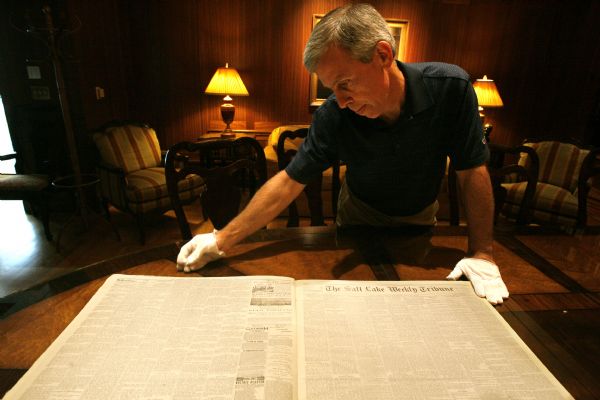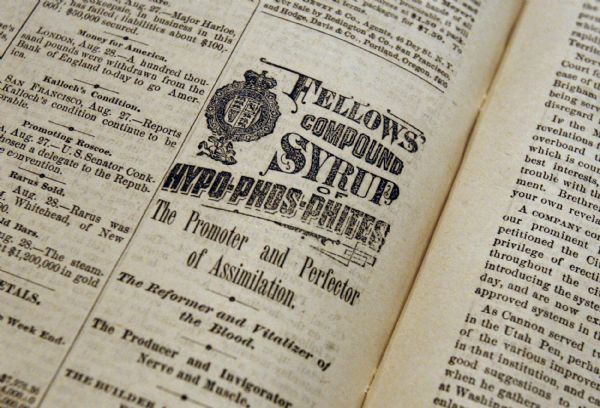This is an archived article that was published on sltrib.com in 2009, and information in the article may be outdated. It is provided only for personal research purposes and may not be reprinted.
Daily newspapers are by definition the most ephemeral of media, a product whose shelf life expires after exactly 24 hours.
But before the digital revolution, many publishers, including those of The Salt Lake Tribune , bound past editions into handy books, preserving history's first draft for future generations.
In the Tribune' s case, that gesture resulted in the accumulation of 2,500 oversized volumes and an enormous cultural responsibility. This month, The Tribune 's corporate parent, MediaNews Group, consummated a donation that transfers ownership of the newspaper's unabridged collected works, 1871 to 2003, to the University of Utah. The university is not only conserving the fragile volumes, but also maintaining public access and digitizing their pages for a searchable database.
It's a deal that benefits everyone, especially the public, says Salt Lake City bookseller Ken Sanders, who appraised the collection.
"The donation is huge. It's 130 years of continuous newspaper publication in the West," Sanders said. "What is such a thing worth historically? It's priceless."
But were it something you could buy with a MasterCard, Sanders did assign a monetary value: $650,000. The gift features about 100,000 issues of not only The Tribune but incomplete runs of long-extinct publications, notably the Junior Tribune, Salt Lake Telegram, Salt Lake Herald, Salt Lake Times, Salt Lake Democrat and Intermountain Republic.
"We are pleased to contribute our historic newspapers to this fine university, and through them to the people of the great state of Utah," said William Dean Singleton, founder and chief executive of MediaNews Group, the Denver-based newspaper chain that bought the Tribune in 2000. "It's been said that newspapers are the first draft of history so it is fitting they be kept in the U.'s library, where they can be accessed by interested citizens and researchers as well."
Tribune Editor Nancy Conway said the U. is the ideal place for the newspapers: "What better home for the archives of Utah's independent newspaper than Utah's independent university? We hope they will be well used."
Old newspapers are a crucial resource to historians, but The Tribune is especially vital for the role it played in Utah's territorial life when it was a theocratic stronghold called Deseret.
"It was important in Utah because we were such a monolithic culture," Sanders said. The 19th century Tribune was famous for its vitriol against the Church of Jesus Christ of Latter-day Saints, an institution equipped with its own mouthpiece, the Deseret News .
" The Tribune came about not so much as an anti-Mormon voice. It was more a part of the Godbeite movement of the 1860s, advancing the idea that Brigham Young was leading the [LDS] church astray," Sanders said.
A glance at fading pages from the late 1870s, when the news was crammed into tiny type arranged over nine columns, show a preoccupation with mining, but also with local idiosyncrasies. In May 1879, the newspaper reports, a jury convicted John Miles of bigamy, for which he was sentenced to five years in prison and ordered to pay $100. Another story describes a bishop's "hoodlum son" who could curse in 16 languages, including the Deseret alphabet. Patent medicines were common advertisers, including Fellows Compound Syrup of Hypo-Phos-Phites, a "promoter and perfecter of assimilation."
The Tribune's rise to regional prominence began in 1901 after its purchase by U.S. Sen. Thomas Kearns, a Catholic who had just been installed in the Senate by an LDS-dominated Utah Legislature. The Kearns family members and their descendants controlled the paper until MediaNews took over.
A convergence of happenstance greased the physical transfer of the 10-ton cache of newsprint last summer when the collection was facing eviction. MediaNews was getting ready to sell the historic masonry high-rise at 143 S. Main St., where the newspaper was published from 1937 to 2005.
For decades, the volumes sat in the building's dark basement at the mercy of plumbing leaks and mice, hardly an ideal climate for a treasured archive. Last year, new humidity-controlled storage space was coming on-line under a massive renovation of the U.'s Marriott Library. Special collections managers and Tribune executives agreed to have the volumes moved to the library and a crew spent three days hauling them out of the downtown basement.
The slender volumes from the 19th century were already at the Marriott, then on loan for the U.'s ambitious newspaper digitization project. Officials hope to scan 8 million pages from 50 Utah newspapers, including The Tribune's entire run.
"We've been at this since 2002. We've processed 700,000 pages. That's 10 percent in seven years. We have a ways to go," said John Herbert, head of digital technologies at the Marriott. The public can search this content at http://digitalnewspapers.org" Target="_BLANK">digitalnewspapers.org.
bmaffly@sltrib.com" Target="_BLANK">bmaffly@sltrib.com





